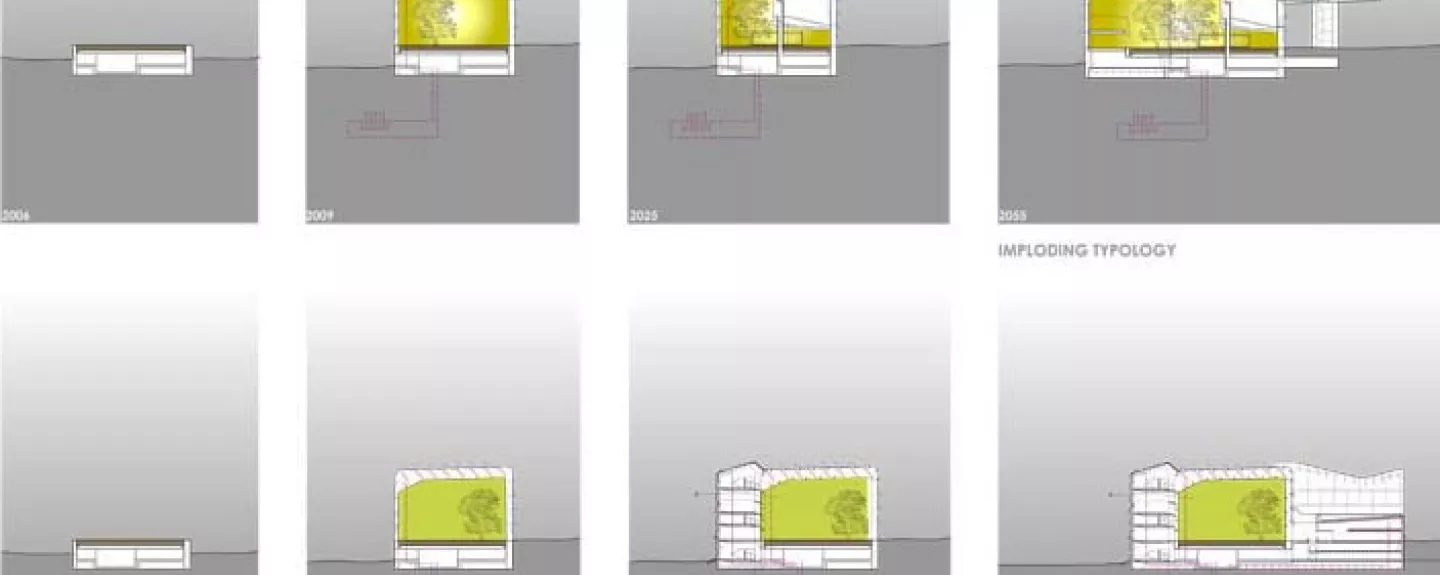Project:
Planting Seeds

About
-
“Planting Seeds” proposes a mechanism for increased development in a ‘re/covering’ landscape. Instead of adopting a formal solution, the strategy thickens and enlivens the site over a fifty-year period. In contrast to usual urbanization patterns, buildings and landscape evolve reciprocally over time, their complimentary interactions supporting a multifunctional urbanity. “Planting seeds” demonstrates how new infrastructure, housing, commerce, recreation, land remediation processes and ecological systems can interact gradually and be allowed to thrive with different degrees of interdependency, and offers an alternative to the generic extension of the city onto the lake.
As the landscape matures, the project restores the site’s diverse shoreline edge condition and wetland habitat. In concert, a new architectural skin grows around the initial public activities, hosting residential, office and commercial uses, expanding upward and outward. These skins provide circulation, mechanical conduits, thermal insulation, solar energy and heat exchange, recycling resources of air, water and energy.
The site, as it matures over fifty years, becomes one primed for research, innovation and experimentation. Strategically positioned in connection with existing fabric, it provides amenities, captures elapsed memory, provides cultural contributions and demonstrates the value of nature in the reconnected city. -
Planting Seeds takes the contaminated ground of the competition area and the relatively slow city expansion a condition for investigating a strategy a for phased development. The first step is to put several platforms with public programmes into the study area. Each platform has a specific programme such as theatre, greenhouse, spa and swimming pool, convention centre, etc.
At the same time, the area is made accessible for the inhabitants by creating a series of connecting bridges across the rail tracks. The bridges create a direct link between the city and the platforms, weaving the urban tissue together. An important move is to investigate the relationship between these urban seeds and the waterfront.
This allows for a varied waterfront shaped by the specific functions of each urban hotspot. The diagrammatically illustrated waterfront shows a great liveliness in how it relates built and open spaces.As the platforms (seeds) develop, they "grow", becoming urban blocks. The open spaces of each platform end up as interior public spaces, encircled with building structures. Despite being loose and not integrative, this strategy offers an interesting vision of the site, one that reject the generic future that the current city plan promotes. It allows the enormous Strandsonen area to develop over time and not according to a preconceived image.
The jury questioned how the platform seeds could actually grow over time. Still, the project is highly original and sophisticated in its approach and prepares the ground for a high quality urban development.
This project has visualized, in a daring way, how the people of Hamar can play a vital role in a developing their own city.The jury recognizes the seedling strategy as an intelligent and poetic way of linking the city and the new waterfront development areas together. Planting Seeds gives a new dynamic to the abandoned area, allowing time and space for a flexible urbanization of Lake Mjøsa.
-
Competition team
Marc Brossa (ES)
Julio Salcedo (ES)
architects
Guri Nadler (IL)
urban planner
Christine Graziano (US)
Joe Mauer (US)
Landscape architects
So Young Park (KR)
architect
Kyung Ok Do (KR)
interior architect

